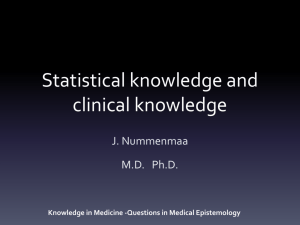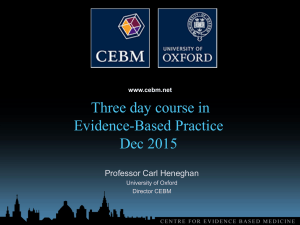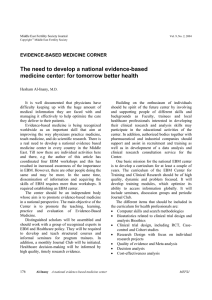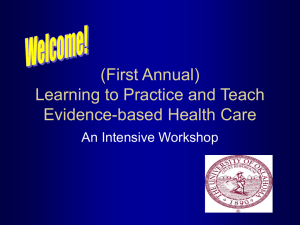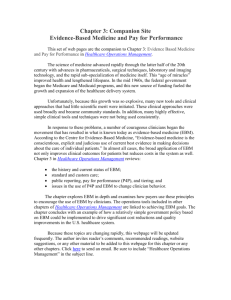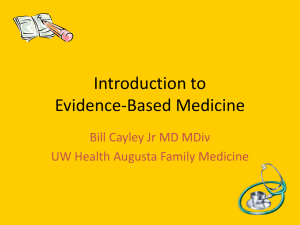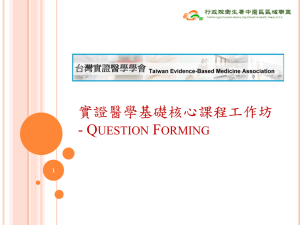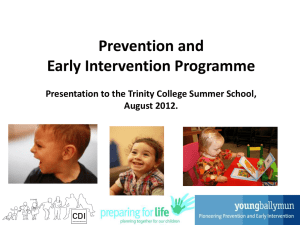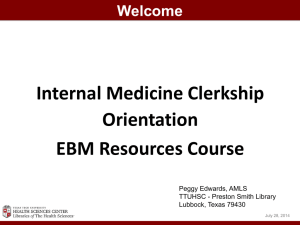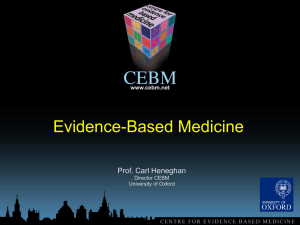Non-Small Cell Lung Cancer: Recent Advances and the
advertisement
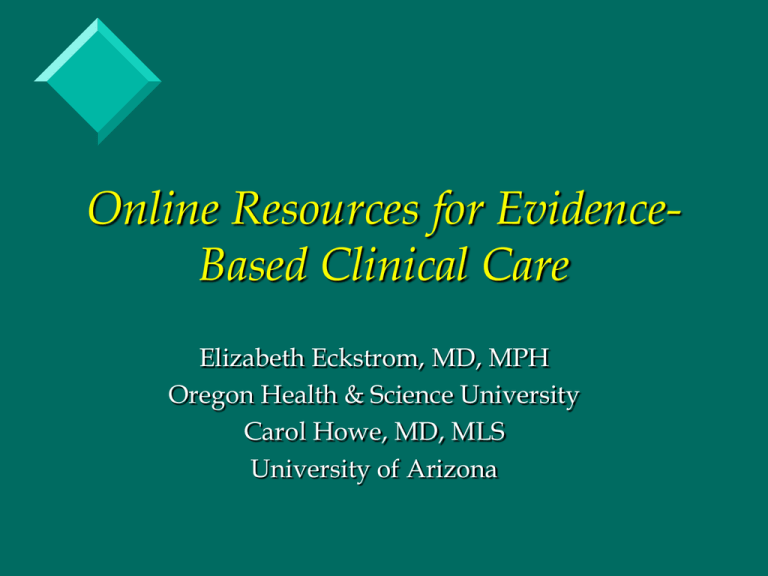
Online Resources for EvidenceBased Clinical Care Elizabeth Eckstrom, MD, MPH Oregon Health & Science University Carol Howe, MD, MLS University of Arizona Today we will: Discuss levels of evidence and how to efficiently find the highest level of evidence for your question Differentiate foreground and background questions and find the best evidence for each Practice using some of these resources Mr. Drake Mr. Drake is a 72 year old new patient to your practice. He has a history of HTN and CAD, both medically managed and stable. He exercises regularly, and is enjoying retirement; doing lots of travel with his wife. He wants to plan well for his wife’s future, so is wondering what is his risk of having a heart attack in the next five years? He has never had a pneumovax, so you recommend one today. He states he has read the literature and doesn’t think he needs one. You have always followed the recommendation to vaccinate your patients over 65, but decide to review the evidence yourself so you can show him why he needs vaccination. Foreground vs Background questions 5 year prognosis for patients with stable HTN and CAD Pneumonia risk reduction with pneumovax in a fairly healthy 72 year old What is the best evidence you could find to answer these questions? pyramid modified from: Navigating the Maze, University of Virginia, Health Sciences Library. From The University of Washington https://healthlinks.washington.edu/ebp/ebptools.html Background Questions Background questions tend to be general questions about a disease such as – – – – typical clinical presentation epidemiology natural history treatment. For Background questions…. Textbooks Textbook databases : Stat!Ref; MD Consult; AccessMedicine UptoDate -essentially a continuously updated online textbook Clinics of North America-quarterly journal of review articles eMedicine- part of Medscape-regularly updated point of care reference. (FREE For health care providers) Other resources you find useful and reliable? Foreground Questions Foreground questions are much more focused, targeted questions. PICO is an ideal mnemonic for helping to build an answerable question. The nature of the question will help you determine the best strategy for how to answer it. PICO P-patient, population or problem I-Intervention (diagnostic test, exposure, prognostic factor, therapy) C-Comparison- (population without that disease, placebo drug, comparison drug) O-outcome-Measurable outcome such as improvement in symptoms, adverse effects, mortality. Clinical questions usually fall into these categories: Etiology (can also include Cause and Harm) Diagnosis Therapy (also includes Prevention) Prognosis What is the best evidence you could find to answer these questions? pyramid modified from: Navigating the Maze, University of Virginia, Health Sciences Library. From The University of Washington https://healthlinks.washington.edu/ebp/ebptools.html Type Of Question Suggested best type of study Diagnosis prospective, blind comparison to a gold standard Therapy RCT > cohort > case control > case series Prognosis cohort study > case control > case series Harm/Etiology RCT > cohort > case control > case series Prevention RCT > cohort > case control > case series Clinical Exam prospective, blind comparison to a gold standard Cost Benefit economic analysis From Introduction to Evidence-Based Practice, Duke university Medical Center Library and Health Sciences Library, UNC-Chapel Hill http://www.hsl.unc.edu/services/tutorials/ebm/welcome.htm For most foreground questions: Look in first in “filtered” or “preappraised sources” such as the Cochrane Library ,ACP Medicine (available also from Stat!Ref), or BMJ Clinical Evidence (to name just a few!) If there is no recent review, PubMed has some excellent options —which we will spend most of the rest of our time reviewing Sources for further exploration: Introduction to Evidence-Based Practice, Duke university Medical Center Library and Health Sciences Library, UNC-Chapel Hill . Fifth Edition. (updated July 2010) http://www.hsl.unc.edu/services/tutorials/ebm/index.htm University of Illinois: Evidence Based Medicine: Finding the Best Clinical Literature . Last updated 2008 www.uic.edu/depts/lib/lhsp/resources/ebm.shtml SUNY Downstate Medical Center Evidence Based Tutorial (last updated 2004) http://library.downstate.edu/EBM2/contents.htm Centre for Evidence-Based Medicine Toronto http://ktclearinghouse.ca/cebm Buckingham J, Fisher B, Saunders D. Evidence-Based Medicine: mini manual. Based in part on the Evidence-Based Medicine Toolkit, http://ebm.med.ualberta.ca/ . Last updated July, 2009. http://www.med.ualberta.ca/dsme/documents/Minimanual2009.pdf

